How to Locate and Catch More Tarpon with Side Imaging Sonar [New Age Sight Fishing]
Tips for locating tarpon that are not rolling on the surface and how to read side imaging from full-time tarpon guides.
In 2005, Humminbird introduced the first consumer side-scanning sonar products featuring Humminbird’s patented Side Imaging® technology. This new technology was first adopted and utilized by freshwater anglers targeting bass, stripers, walleye, musky, panfish, and the like; however, saltwater anglers soon recognized the value of this unique technology and adopted it for use in the marine saltwater environment.
Today, as the Side Imaging technology and capabilities have significantly and constantly improved, more and more saltwater anglers are adding MEGA Side Imaging capable electronics to their boats to take advantage of their unmatched utility on the water.
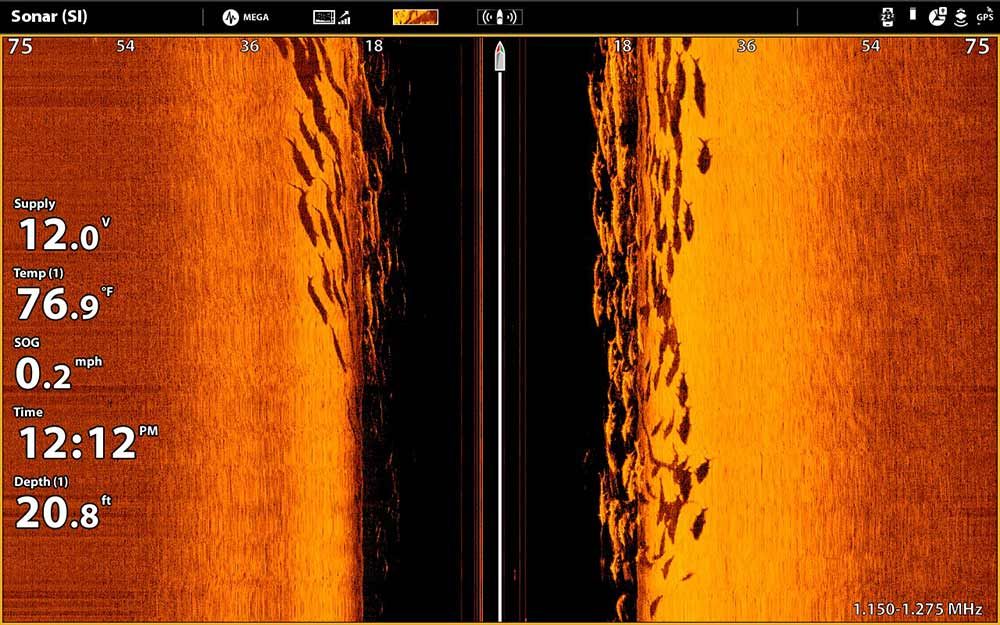
Unlike conventional sonar which return images of what is under or has passed under your boat, Side Imaging sonar return images of what is or has passed on each side of your boat, to the left and right. As such, Side Imaging provides a significant advantage over conventional sonar in that it covers considerably more water.
This distinction is important when looking for bottom structure or fish because it allows you to see and scan more water with your passing boat than you would if you were only using conventional sonar.
For example, if you have approximate GPS coordinate numbers for a wreck and are using conventional sonar, you have to pass your boat almost directly over the wreck in order to find it and see it on your sonar screen. If your GPS numbers are off the mark of the exact location of the wreck even slightly, it might take you several boat passes, and more importantly much more time to actually find the wreck that you are looking for.
Conversely, with MEGA Side Imaging’s ability to look up to 200 feet left and 200 feet right of your boat, you are able to see more area around your boat with each pass, which means you will find the spot faster and spend more time fishing.
How to read Side Imaging sonar
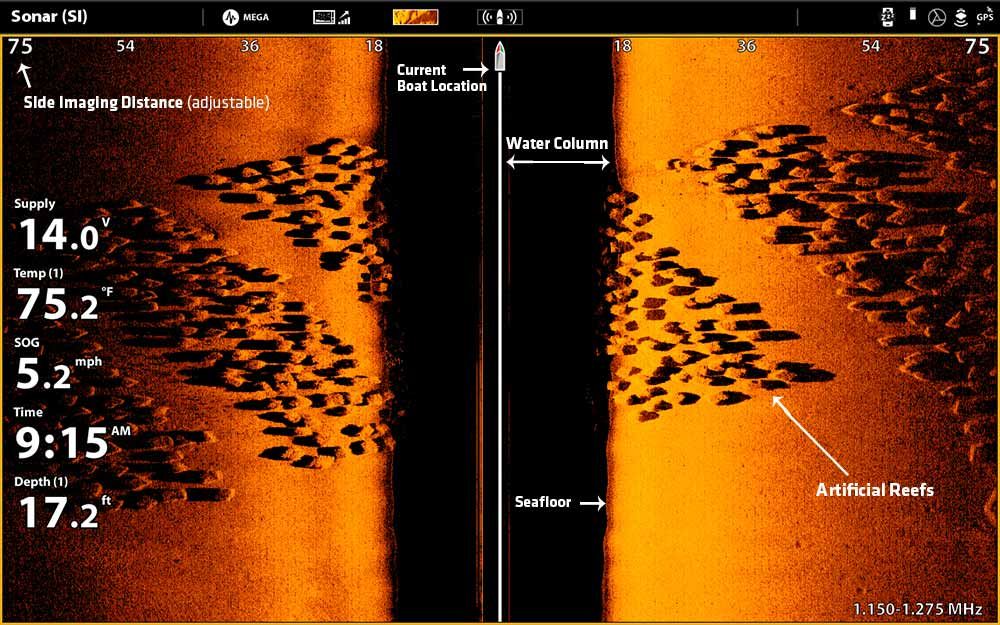
Many anglers are used to conventional sonar where your boat position is located in the top right-hand corner of the unit’s screen and the newest sonar data passes from the right-hand side of the screen to the left over time, However, with Side Imaging, it is important to understand that your boat position is centered at the top of the screen, and the sonar images passes from the top side of the screen to the bottom side of the screen over time.
The Side Imaging view can be set to look either to both the left and right of your boat at the same time, just to the left, or just to the right.
Interpreting the return image provided by Side Imaging requires a little bit of a learning curve, as it is slightly different from what anglers are familiar with from conventional down view sonars. With Side Imaging, the centerline on the screen separates the port and starboard side of the boat, providing a reference to where the object is in relation to the boat. Moving out to either edge of the screen from the white center line, there is a black area on the screen that represents the water column underneath your boat.
Once you reach the outside edge of the black bar that represents the water column, there will be a colored area, which shows the bottom located just to the left and right of the centerline of your boat.
Based upon your set range of Side Imaging distance, the area from the bottom contact out to the left and right edges of your screen will show the area from directly under your boat out to your set range to the side in feet.

Bottom structure and suspended fish will show up as bright white lines or dots closer to the center of your screen (especially in the water column) with dark or black shadow images showing the outline of the structure or fish out closer to the sides of your screen. When using Side Imaging, seeing and interpreting these shadows is essentially the best tool that Side Imaging offers to visualize and identify the structure and fish shown to the sides of our boats.
As Side Imaging technology has advanced over the years from using Kilohertz sonar frequencies to now Megahertz sonar frequencies, the images now viewable with MEGA Side Imaging sonar units like the Humminbird SOLIX and Helix models are simply unmatchable in clarity, sharpness, and detail.
With these new MEGA Side Imaging units, it is now possible to positively identify specific species of fish shown on your screen. For the first time ever, this technology provides anglers with the tool to cover water while looking for their specific targeted species and then position their boat precisely to make precise bait or lure presentations.
Using Side Imaging to Locate and Catch More Tarpon
Captain Mark Bennett (www.tarponsnook.com) has been a full-time fishing guide for twenty-six years and makes his living plying the inshore and backcountry waters off Florida’s Southwest coast from Boca Grande south to the Florida Everglades and Upper Keys. According to Mark, “MEGA Side Imaging from Humminbird is a game changer”. While Mark and his clients fish for all of the typical inshore species, Mark’s favorite fish to target are tarpon.
“When fishing for tarpon, we used to drive around or post up on known areas looking for signs of tarpon in the area. We classically looked for rolling and daisy chaining tarpon, tarpon pushing water, and fish cruising that were visible to the eye. That method works great when the water is clear, when the wind isn’t blowing a gale, and when the fish want to show themselves; but, when the conditions are not ideal for sight casting, tarpon fishing can get downright difficult” added Bennett.
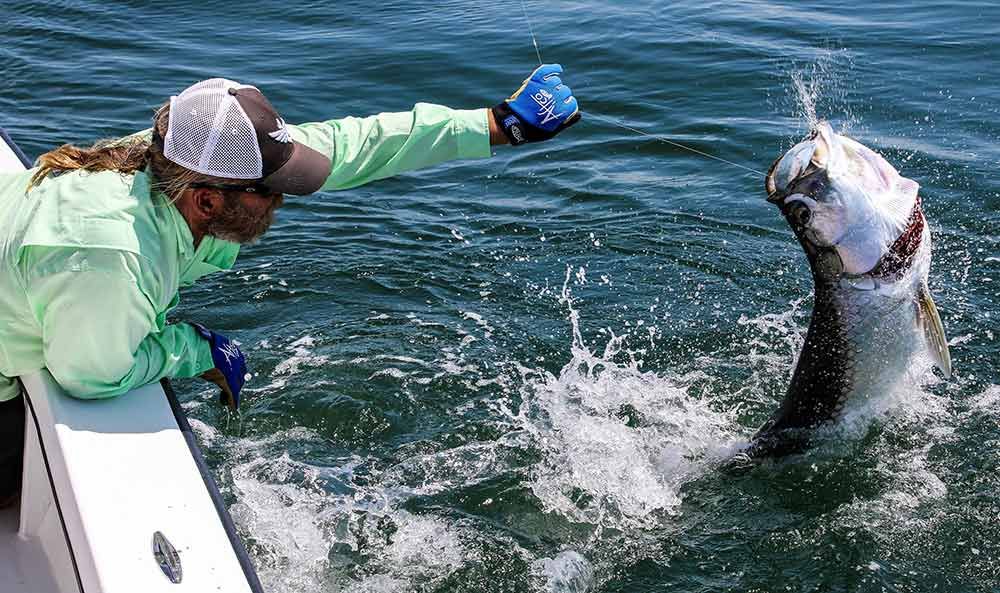
“MEGA Side Imaging has changed all of that. Now, we can locate and see the tarpon on our Humminbird MEGA Side Imaging units even when we cannot see them with our eyes. With MEGA Side Imaging, it doesn’t matter how hard the wind is blowing, how dirty the water is, or whether or not the tarpon are rolling or showing themselves.
Now, we can use our Minn Kota trolling motors to move around looking for tarpon on our Humminbird MEGA Side Imaging units and make accurate casts left and right of the boat to tarpon that we otherwise (and previously) never would have even known were near us.
"The Humminbird MEGA Side Imaging display is so sharp, accurate, and detailed that you can even clearly see which direction the tarpon are facing and make an accurate cast or position the boat accordingly" added Bennett.

Mark told one particular story about a recent tarpon fishing trip in the Florida Everglades in which MEGA Side Imaging saved the day. He had fished a specific backcountry bay the day prior with great success putting his clients on several silver kings that were rolling around his boat and exceptionally willing to make their presence known.
However, the next morning was a completely different story. The temperature dropped and wind increased overnight and by the next morning, there wasn’t a sign of a single tarpon in the area.
Feeling dejected and otherwise resolved to push on and look for tarpon elsewhere, he used his Minn Kota Riptide Ulterra trolling motor to motor his way out of the bay.
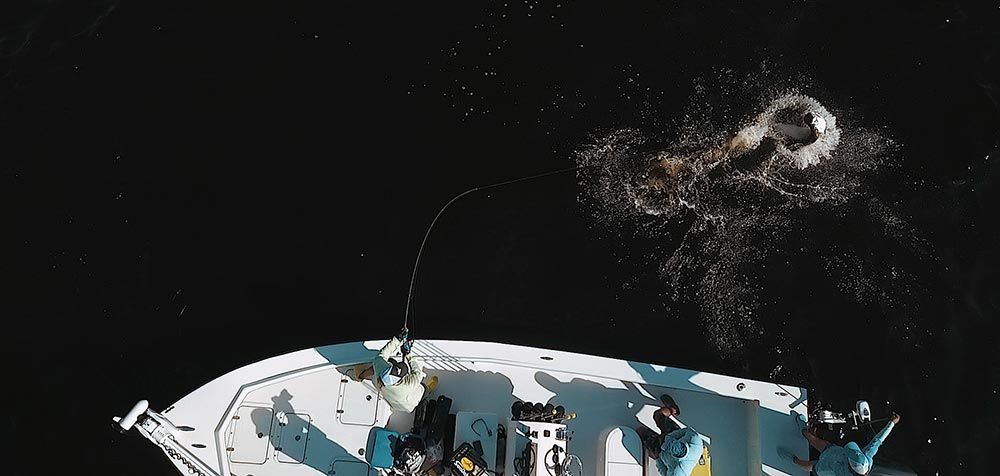
On his way out to open water, while watching his Humminbird SOLIX, he found the group of tarpon that he never thought would be there. By using his Humminbird SOLIX, Mark was able to determine that the tarpon were around 75 feet to the left side of his boat, facing parallel with the bow of his boat.
Mark instructed his client to make a cast slightly ahead of port midship and around 80 feet, resulting in an almost immediate hookup on a big tarpon. They landed the tarpon and Mark repeated the same procedure several times throughout that morning resulting in several hookups and releases for his client.
According to Mark, “If we didn’t have Humminbird MEGA Side Imaging on that boat that day, we would have left that bay thinking that there were no fish there”.
Using Humminbird Side Imaging in Saltwater
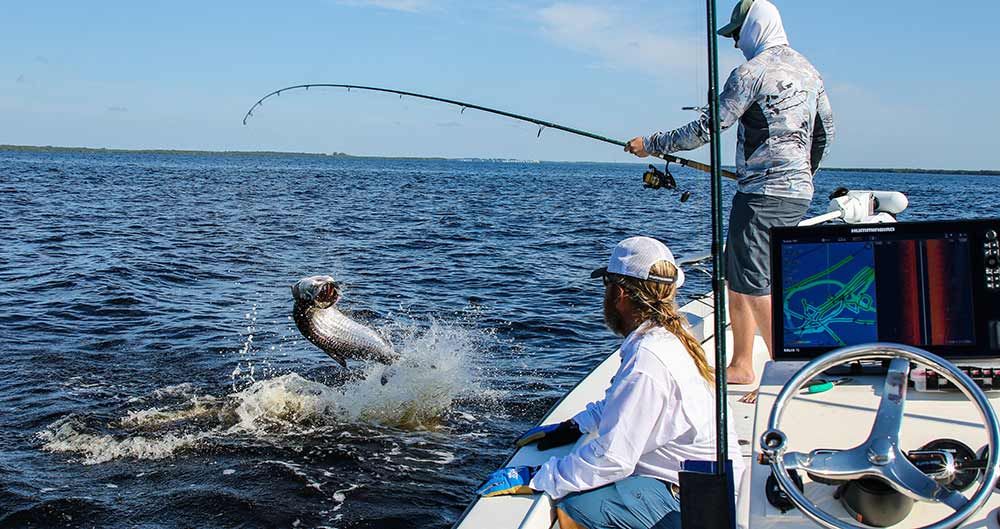
While Side Imaging excels in shallow water, it is also a useful tool for nearshore, reef, and offshore anglers as well. Side Imaging provides these anglers an unparalleled view of the bottom relief, natural reef structure, artificial structure, and wrecks; and, the schools of baitfish and predator fish surrounding them. And with the sharpness and detail of MEGA Side Imaging, anglers can differentiate individual fish from the structure.
While using Humminbird MEGA Side Imaging over a nearshore sunken barge offshore of Stuart, Florida, we were able to clearly see images of goliath grouper milling around the outside structure of the barge and bull sharks circling over the top of the barge.
Others have used MEGA Side Imaging to locate schools of tarpon amongst the bridge spans of the Seven Mile Bridge down in the Florida Keys. Yet, others have used Mega Side Imaging to locate ledges to dive on to harvest lobsters.
No matter where your saltwater fishing pursuits take you, you should consider adding Side Imaging technology to your fishing toolbox. Not only will it make your time on the water more productive, it just might save the day when the conditions don’t allow you to sightfish your target species.







